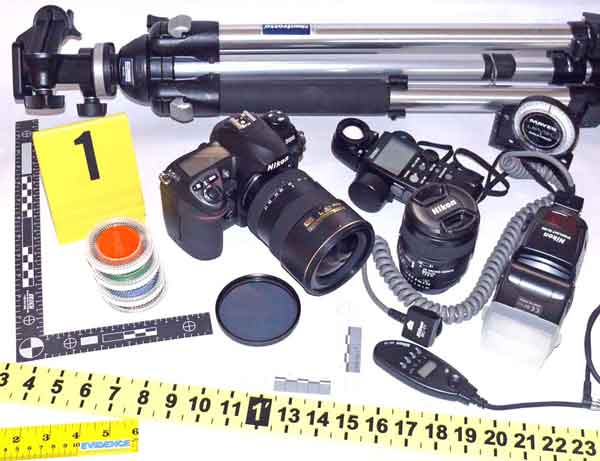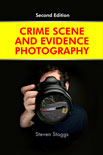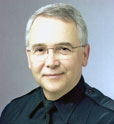Crime Scene Photography Kit
Steven Staggs

The following items should be available to the crime scene photographer in order to photograph most scenes and evidence:
- Camera
Most crime scene photographers use a high quality digital camera or 35mm camera. Digital cameras which have twenty megapixel, or greater, image sensors and manual exposure settings (in addition to any automatic or programmed exposure modes) are usually suitable for crime scene and evidence photography. - Normal lens
A normal lens provides the best perspective for most photographs. A 50mm lens is considered a normal lens for a 35mm camera. - Wide–angle lens
A wide-angle lens is needed when photographing small rooms or other space–constricted areas. A 28mm lens is considered a wide–angle lens for a 35mm camera. - Close–up lens or close–up accessories
Most normal lenses do not focus closer than about three feet. A macro lens or a close–up accessory for the normal lens is needed to photograph small items of evidence. Close–up accessories include 1:1 adapters, extension tubes, bellows, reversing rings, or close–up filters. - Filters
A polarizing filter is often needed for photographing through glass and into water. Colored filters (red, orange, yellow, blue, and green) are useful when photographing certain types of evidence with black–and–white film. - Electronic flash
Electronic flash provides additional light that is often needed when photographing indoors, outdoors at night, filling in shadows in bright daylight scenes and for lighting evidence. - Remote sync cord for electronic flash
A remote sync cord allows the electronic flash to be operated when it is not mounted on camera. Many photographs, especially photographs of certain types of evidence, cannot be photographed with the flash mounted on the camera. - Extra camera and electronic flash batteries
Batteries can expire without warning during the documentation of a scene. Extra batteries for both the camera and electronic flash should be included in the camera kit. - Locking cable release
A locking cable release is used to lock open the camera's shutter during long exposures and when using the “painting with light” technique for photographing large nighttime scenes. Cameras that have a built-in feature that locks open the shutter do not require a locking cable release. - Tripod
Tripods are necessary to steady the camera for long exposures and for positioning the camera during certain types of evidence photography. - Film
Medium speed (ISO 100 or 200) color print film is most often used for crime scene photography. Black–and–white film is used for certain types of evidence photography. - Operation manuals for camera, electronic flash and accessories
Equipment operating manuals should be carried in the field for reference. With the many features on modern cameras and electronic flash units, it may be necessary to refer to the manuals for specialized photographic techniques. - Photo log, notebook and pen
A photo log is necessary for recording information about each photograph taken at a crime scene. A notebook is valuable for recording other notes during the investigation. - Scales and tape measure
A variety of scales, including 6 inch and 36 inch sizes, must be available for photographing different types of subjects. Long tape measures with large numbers are sometimes necessary when photographing large items of evidence or large areas in a crime scene. - ABFO #2 scale
The ABFO #2 scale is the preferred scale for photographing injuries. - Angle–finder
An angle finder is used to help position a camera for photographing certain types of evidence at the crime scene. - Color chart or color control patches
Color chart or color control patches are useful as color references in injury photography - 18% gray card
The 18% gray card is used as an aid in getting accurate exposures. - Index cards and felt pen
When a number or other identifier is need in a photograph, simply write the number or identifier on an index card and place it in the photograph. - Flashlight
A flashlight not only helps you see in dark areas, but it is useful for previewing lighting during evidence photography. By shining the light on evidence from different angles you can see where it is best to position the electronic flash for a photograph.
Other Equipment to Consider
- Telephoto lenses
While telephoto lenses are seldom used in crime scene photography, they are necessary for most types of surveillance photography. - Supplementary light meter
Supplementary light meters are usually more effective than the metering system inside the camera and are most useful for low light level readings, such as ambient light photography at night. - Small tools
Small tools are helpful when emergency camera repairs must be done in the field. - Devices for positioning evidence and scales
Blocks of wood, clothespins, clamps and other devices can be used for positioning evidence and scales for close-up photography. - White handkerchief or other flash diffusion material
A white handkerchief or similar material can be placed over the head of an electronic flash unit to reduce the intensity of the flash.
 Basic Crime Scene and Evidence Photography Kit Copyright: © 2014 by Steven Staggs. Copyright for this article is retained by the author, with publication rights granted to the Crime Scene Investigation Network. This is an Open Access article distributed under the terms of the Creative Commons Attribution-NonCommercial-NoDerivatives 4.0 International License which permits
unrestricted noncommercial use, distribution, and reproduction, provided the original work is
properly cited and not changed in any way.
Basic Crime Scene and Evidence Photography Kit Copyright: © 2014 by Steven Staggs. Copyright for this article is retained by the author, with publication rights granted to the Crime Scene Investigation Network. This is an Open Access article distributed under the terms of the Creative Commons Attribution-NonCommercial-NoDerivatives 4.0 International License which permits
unrestricted noncommercial use, distribution, and reproduction, provided the original work is
properly cited and not changed in any way.
About the Book

The information presented in this article is from the book Crime Scene and Evidence Photography, 2nd Edition © 2014 by Steven Staggs.
About the Author
 For 34 years Steven Staggs was a forensic photography instructor and trained more than 4,000 crime scene technicians and investigators for police and sheriff departments, district attorney offices, and federal agencies. He was also a guest speaker for investigator associations, appeared as a crime scene investigation expert in several episodes of Discovery Channel's Unsolved History, and provided consulting to law enforcement agencies.
For 34 years Steven Staggs was a forensic photography instructor and trained more than 4,000 crime scene technicians and investigators for police and sheriff departments, district attorney offices, and federal agencies. He was also a guest speaker for investigator associations, appeared as a crime scene investigation expert in several episodes of Discovery Channel's Unsolved History, and provided consulting to law enforcement agencies.
Steve has extensive experience in crime scene photography and identification. He has testified in superior court concerning his crime scene, evidence, and autopsy photography and has handled high profile cases including a nationally publicized serial homicide case.
Steve is the author of two books on crime scene and evidence photography, the text book Crime Scene and Evidence Photography and the Crime Scene and Evidence Photographer's Guide. The guide is a field handbook for crime scene and evidence photography, which sold over 10,000 copies and has been in use by investigators in more than 2,000 law enforcement agencies.
Steve retired in 2004 after 32 years in law enforcement, but continued to teach forensic photography and crime scene investigations at a university in Southern California.
Article submitted by the Author
Article posted: September 24, 2014

